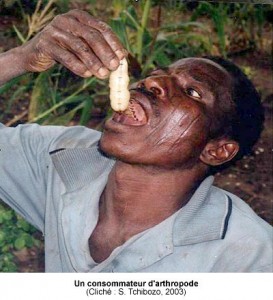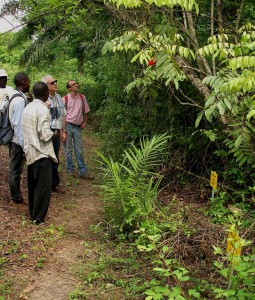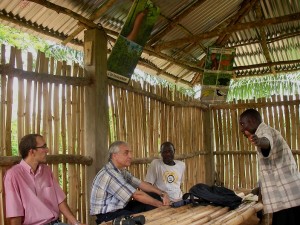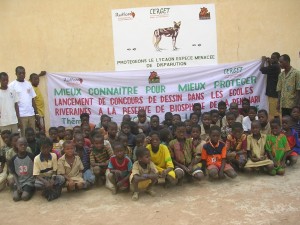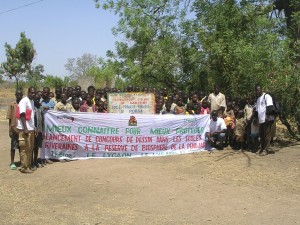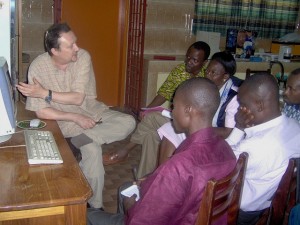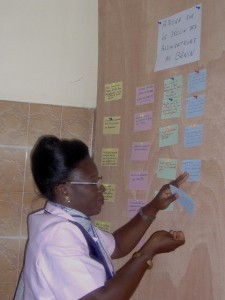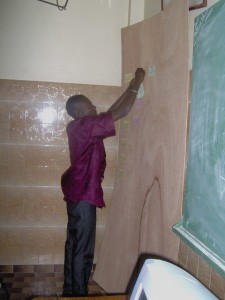2009-2010
16. Les insectes comestibles d’Afrique francophone de l’Ouest et du Centre sur Internet : LINCAOCNET (FONDS FRANCOPHONE DES INFOROUTES, Institut de la Francophonie numérique (IFN), Organisation internationale de la Francophonie et Biodiversity Information and Cybertaxonomy Unit, Royal Museum for Central Africa, www.africamuseum.be
Sévérin Tchibozo, CRGB Bénin; Patricia Mergen et Franck Theeten, MRAC/CABIN Belgique; Edmond Dounias et Philippe Le Gall, IRD France et Henri-Pierre Aberlenc, CIRAD/CSIRO France.
Pays concernés : Bénin, Togo, Niger, Burkina-Faso, Mali, Guinée Conakry, Cameroun, Centrafrique, Congo Démocratique et Congo.
Fiche de vulgarisation
Septembre 2009 à Décembre 2010
Résumé : La faune entomologique constitue aussi une source de protéine animale qui doit être bien conservée et utilisée à des fins rationnelles. L’utilisation des insectes comestibles comme source de protéine doit être encouragée dans divers points du globe car ceux-ci contribuent à la réduction de l’insécurité alimentaire.
527 espèces d’insectes sont consommées par les humains dans 88 pays, en Afrique, en Asie, et en Amériques (Courrier de l’environnement de l’INRA, 2008). L’absence d’information mise en ligne et d’ouvrages de synthèse sur les insectes comestibles d’Afrique francophone de l’Ouest et du Centre constitue un handicap pour l’enseignement et la pratique de l’entomophagie.
La production de ce type de travaux, que ce soit sous format digital ou sous format papier, constitue pourtant un préalable essentiel à une meilleure connaissance scientifique et un meilleur usage alimentaire des insectes. Outre les publications de François Malaisse sur l’exploitation alimentaire de la forêt claire africaine, qui incluent l’entomofaune la seule information anglophone actuellement accessible en ligne sur les insectes comestibles du monde est à notre connaissance le site de Gene De Foliart.
Assez ancienne et uniquement anglophone, cette source d’information renseigne très peu sur l’Afrique francophone de l’Ouest et du Centre et ne permet pas de toucher facilement un public francophone. Afin de réduire notre ignorance de l’entomofaune comestible africaine, nous souhaitons réaliser une mise en ligne des données existantes et en collecter aussi.
Les résultats attendus du projet permettront :
– de diffuser le plus largement possible des informations sur les insectes comestibles, via le site Internet
– de fournir des informations sur le rôle de la consommation d’insectes comme produits forestiers non ligneux dans l’apport alimentaire, la protection de la, biodiversité, ainsi que leur signification culturelle
– de contribuer à une meilleure conservation des insectes comestibles.
Ces résultats seront très utiles pour les chercheurs, enseignants, techniciens, nutritionnistes, ethnologues, naturalistes, ONG pour la protection de la nature africaine, sociétés entomologiques, etc. actifs dans la région. Ils font également partie des priorités du plan d’action de la conservation et l’utilisation durable des ressources biologiques.
Ce projet représente aussi une importante contribution francophone aux programmes principalement anglophones que sont :
* Le programme CEPDEC (Capacity Enhancement Programme for Developing Countries) du GBIF (Global Biodiversity Information Facility) pour l’amélioration de l’infrastructure informatique des pays en voie de développement.
* SEP (Plant-expert Sud).
* Le TDWG (Taxonomic Database Working Group), consortium de scientifiques pour l’élaboration de logiciels et de standards d’échange communs dans le domaine de la taxonomie et de la biodiversité.
15. Mitigation of human-lion conflicts in Pendjari Biosphere Reserve (Dry And Sub-humid Small grants Programme, Netherlands Committee-UICN & ROCAL.
Tehou Aristide, Pendjari National Park / ROCAL & Etotépé A. Sogbohossou, CRGB / ROCAL.
2005-2006 and 2008-2010
Summary :
Human-wildlife conflicts are among the threats to lion and other carnivores conservation in West Africa. The Network for lion Conservation in West and Central Africa (ROCAL in French) has secured funds from the Netherlands Committee for IUCN to contribute in the region to mitigate these conflicts in order to save the declining large carnivores populations of the region.
In Benin, the small grant has been used to help Fulani herders to build predator-proof enclosures for their cattle around Pendjari Biosphere Reserve. We also helped herders to plant some threatened tree species that are used during the dry season to feed cattle. As at least a part of their cattle is kept in enclosures, cattle dung is accumulated, herders were trained in composting. Organic cotton is being developed in the area and the organic manure could be used for this purpose.
Monitoring showed that enclosures are effective in reducing livestock depredation frequencies. More herders are willing to be included in the project but the finds were too small to include all of them.
14. Collaboration between, Benin, Bhutan and Costa Rica in capacity development for biodiversity information management (http://www.fundecooperacion.org.
Randall García, INBio Costa-Rica, Medom Yaganagi, NBC Buthan and Séverin Tchibozo CRGB Benin.
Février 2008 à février 2010
Résumé : Specifically, this project includes: software development and management activities between the three countries in order to build capacities in Biodiversity Information Management.
In order to maximize the potential for reciprocity and sharing of mutual benefits, the project fosters the collaboration between NBC, INBio, the CRGB and their national partners through trainings, technical assistance and the exchange of information and experiences. This proposal is centered in two of the three expected results of objective 3 of the Program for South South Cooperation (donor):
– Institutions and organizations that promote conservation of national patrimony of biodiversity are strengthened in the three partner countries. </li>
– New knowledge generated and used as input for improvement of national policies for conservation of biodiversity.
The project is given attention to the priority shared by Benin, Bhutan and Costa Rica to “support information mechanisms (formal and informal) for information to public and private sectors for conservation and sustainable use of biodiversity.
Bhutan’s proposal for the Bhutan Integrated Biodiversity Information System (BIBIS) includes several nodes that will share information with the rest of the national network; in particular, two of those nodes identified are the National Mushroom Center (NMC) and the Medicinal and Aromatic Plants (MAP) of the MoA (nodes of the system).
The organization of a digital data base of institutional information on the biodiversity of Benin as part of Global Biodiversity Information Facility (GBIF), shall also unite the three countries: Benin, Costa Rica and Bhutan.
This project proposal was developed by INBio and NBC, in close consultation with CRGB and the mutual interests of all three parties have been well considered. INBio and NBC even coordinated and financed a meeting in Bhutan in order to resolve the last details of this proposal. It is envisaged to be a two year project that will strengthen the institutional linkages through capacity building of the institutions involved, establish and strengthen the biodiversity information management system in three countries, assess the gaps between the demand in information and what is available. It also aims to put in place a policy and legal framework on information access, sharing and exchange.
2008-2009
13. Conservation et valorisation de la forêt sacrée de Kpinkonzoumé et de l’îlot forestier de Houanvè au Sud du Bénin (Département de l’Ouémé) (http://www.ffem.fr, http://www.afd.fr )
Sévérin Tchibozo, Aïkpé Mensah et Guillaume Bodjrènou, CRGB.
Janvier 2008 à janvier 2009
Résumé : Les forêts de Kpinkonzoumè et de Houanvè, situées en zone humide, sont exploitées de manière parfois anarchiques, ce qui engendre une baisse de la diversité spécifique pour la flore mais également pour la faune associée. Des espèces en voie d’extinction comme le Singe à ventre roux (Cercopithecus erythrogaster erythrogaster), le Sitatunga (Tragelaphus spekei), le grand papillon de jour (Papilio phorcas cramer) sont présentes dans ces forêts.
Le projet vise deux objectifs principaux qui sont la sensibilisation des populations aux problèmes environnementaux pour qu’une habitude écologique prenne naissance et le développement de l’écotourisme.
Visite du Directeur (Fulvio Mazzeo, mazzeof@afd.fr) de l’Agence Française de Développement (AFD), Bénin et de l’un de ses collaborateurs (Guillaume Sallé, salleg@afd.fr) sur le site de Houanvè.
Visite d’un sentier écologique avec les accompagnateurs d’éco-touristes à l’observatoire.
12. Diversity in pholcid spiders (Araneae: Pholcidae) of the sacred forest of South-Benin (http://www.americanarachnology.org).
Sévérin Tchibozo, CRGB and Bernhard Huber, Specialist for Pholcidae, Alexander Koenig Zoological Research Museum, Adenauerallee, Germany.
Résumé : The Benin is among the African countries whose arachnid fauna is most poorly known. The country is located in the dry zone between the forests of central and Western Africa, which is commonly called the “Dahomey Gap”. The Republic of Benin is characterized by a multitude of galleries and sacred forests, and a savanna Soudano-Guinean biome. The diversity of arachnids and more especially Araneae Pholcidae of the tropical forests of West Africa are poorly known. A preliminary inventory in Benin will permit us to have a first preview on this biodiversity.
11. Conservation of the biodiversity of the sacred forest relic of Lokogba to the Southwest of Benin: An ecosystem in Danger (http://www.vantienhovenfoundation.com).
Sévérin Tchibozo and Aïkpé Mensah, CRGB
Novembre 2007 à juillet 2008
Résumé : This urgent biodiversity conservation measure will allow the rescue of plants and animals inhabiting the forest, the forging of relationships with local people in order to educate them about the protection, and the preparation of a preliminary community management plan.
The Couffo and Mono departments conduct very few, if any, ecological studies because the local fauna and flora native to these two great regions have largely disappeared. The remnant forests of the Belia Rapids in Begda and of Adjarala Falls that sheltered exceptional biodiversity have been completely destroyed and transformed into agricultural fields along the entire length of the Mono River. We shall work south of Aplahoue to conserve the biodiversity of the sacred forest of Lokogba. There we find endangered species such as the plants Ceiba pentandra, Milicia excelsa, Khaya senegalensis, Triplochiton scleroxylon and the animals Galago senegalensis, Cercopithecus mona. This remarkable fauna and flora native to this forest are in danger of disappearing if no action is taken soon.
10. Contribution to the conservation of an endangered species, the African wild dog in West Africa,
Etotépé A. Sogbohossou et Séverin Tchibozo, CRGB Bénin; Aristide Tehou, Direction Parc National de la Pendjari (DPNP)
Avril 2006 à avril 2007
Summary :
This project on Contribution to African wild dog conservation aim at contributing to the sustainable conservation of one of the most endangered carnivore species in Africa: wild dog with the participation of local populations by trying to achieve two main objectives: gather available and possible data on wild dog presence, distribution in the two national parks of Benin and educate populations especially school children to conserve wild dog in particular and large and medium carnivores in general.
So the project has one research component on the species and one education component with mainly in schools.
Communication pour un Changement de Comportement (CCC) dans les écoles riveraines de la réserve de biosphère de la Pendjari.
9. Diversité en braconides et apoïdes (Insecta, Hymenoptera) des forêts sacrées du Sud-Bénin(http://www.cbd.int/gti/)
Jean-Luc Boevé, Département d’Entomologie, Institut Royal des Sciences Naturelles de Belgique (IRSNB-KBIN), Séverin Tchibozo, CRGB, Yves Braet, expert des Braconidae et Alain Pauly, expert des Apoïdea.
Mai 2006 à avril 2007
Résumé :
Le projet permettra la récolte de braconides et d’apoïdes dans les forêts sacrées du Sud-Bénin, en y choisissant différents sites plus ou moins anthropogènes. De par leur écologie, ces insectes servent de bio-indicateurs, ce qui nous amènera à pouvoir estimer la biodiversité locale. Les insectes en question seront identifiés et gardés en collection en Belgique. Une collection de référence, pourtant, sera restituée au Bénin et préservée à l’Institut International d’Agriculture Tropicale (IITA). Les résultats obtenus en taxonomie (identifications) et écologie (biodiversité locale) seront diffusés par le biais de publications scientifiques. Par ailleurs, le projet vise à former, au Bénin, plusieurs personnes travaillant déjà dans le domaine de la zoologie et de l’agriculture. Ceci devrait assurer une pérennité dans les effets du projet.
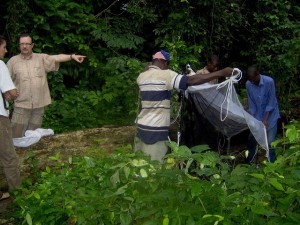
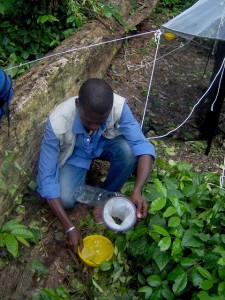
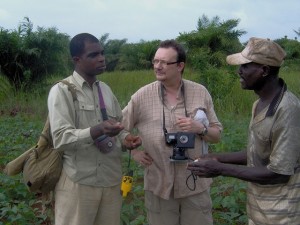
8. Contribution to the conservation of large carnivores in West Africa (http://www.iucn.nl) Etotépé A. Sogbohossou, CRGB Bénin
Mars à octobre 2006
Summary :
Lions, leopards, cheetah … have always played a great economic, cultural, aesthetical role for human being. These last decades, due to human pressure, large cats are threatened by habitat and prey losses and conflicts with humans. In West and Central Africa, there are now confined in protected areas where there is still a threat on them. This situation is the consequence of the illegal exploitation of protected areas by local populations and livestock killing by carnivores. Some efforts are done now to conserve biodiversity and these carnivores. But they can’t succeed if the problem is not correctly assessed, reason why research on these species and their interactions with human is important. More a work on these species should take in account problems between these species and human and also human needs. But there is very few experience in West and Central Africa in large carnivores conservation and integration of populations in this.
That’s why this project aim at contributing to the participatory and sustainable conservation of large carnivores in sudanian protected areas of West Africa especially Benin. The objectives (improve knowledge in carnivores study – learn how people can be involved in carnivores conservation and gather data on human-carnivores conflicts in Benin) will be reached by a trip to the leopard project in South Africa and a preliminary research on conflicts in Benin. The trip has been done in December in South Africa and the field research in November and December.
7. Conservation of threatened medicinal plants by the creation of local botanical gardens managed by local communities in northern Benin (UN CCD-CBD Synergy West and Central Africa)
Etotépé A. Sogbohossou, CRGB / Laboratoire d’Ecologie Appliquée.
6. Conservation du singe à ventre rouge au Sud du Bénin (http://www.iucn.nl)
Séverin Tchibozo, CRGB
Mai à octobre 2003
Résumé : Poursuite des activités de sauvegarde de la sous-espèce du primate dans les zones humides de la base vallée de l’Ouémé. Deux activités génératrices de bénéfices et des reboisements communautaires ont été réalisées.
Quelques photos :
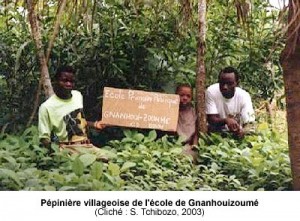
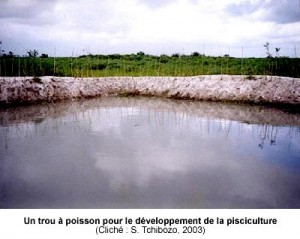
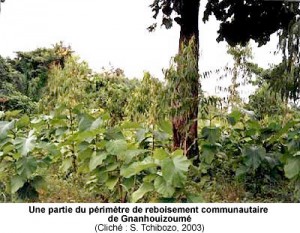
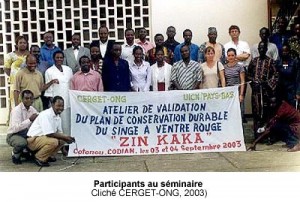
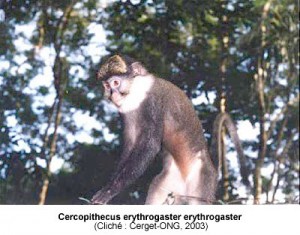
5. Inventaire des arachnides du Bénin (sans subvention)
Séverin Tchibozo, CRGB
Résumé : Un inventaire préliminaire a été fait pour répertorier les arachnides du Bénin.
4. Inventaire des odonates des zones humides du Sud-Bénin, Séverin Tchibozo, CRGB.
Avril à juillet 2002
Résumé : Un inventaire préliminaire a été fait pour répertorier les odonates des zones humides du Sud Bénin.
2001-2003
2. Inventaire préliminaire des invertébrés terrestres (arthropodes) utiles (comestible, médicinale et mythologique) du Bénin (sans subvention)
Séverin Tchibozo, CRGB
Résumé : Les invertébrés utiles comestibles, médicinaux et mythologiques ne sont pas encore bien connus En République du Bénin, nous avions prospecté plusieurs localités et marchés d’animaux morts pour répertorier les usages auxquelles les invertébrés terrestres sont destinés.
